Sarah Schulman at Artforum:
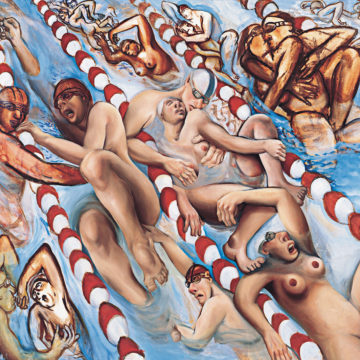 THERE ARE HISTORICAL MOMENTS that transform the industry standard, and sometimes they have deep, traceable roots. An opportunity to understand this process is provided by an exhibition of artist Nicole Eisenman’s work opening in March at Munich’s Museum Brandhorst. Curated by Monika Bayer-Wermuth and Mark Godfrey, the show, especially its revisitation of startlingly explicit lesbian works from the 1990s, will allow viewers to enjoy Eisenman’s beautiful, widely appreciated, and highly valued artworks. The fifty-seven-year-old, French-born, New York–raised painter, sculptor, and creator of wild, passionate murals and drawings has taken a bad-boy, oppositional, and sometimes dramatically risky path to becoming one of the world’s most successful living artists. Somehow, the seas parted and—at times in spite of herself—Eisenman has thrived, has been approved of, and is now in some ways iconic. Beyond the quality of her work, how did it happen that exclusionary criteria that kept a range of lesbian imagery out of the mainstream were lifted?
THERE ARE HISTORICAL MOMENTS that transform the industry standard, and sometimes they have deep, traceable roots. An opportunity to understand this process is provided by an exhibition of artist Nicole Eisenman’s work opening in March at Munich’s Museum Brandhorst. Curated by Monika Bayer-Wermuth and Mark Godfrey, the show, especially its revisitation of startlingly explicit lesbian works from the 1990s, will allow viewers to enjoy Eisenman’s beautiful, widely appreciated, and highly valued artworks. The fifty-seven-year-old, French-born, New York–raised painter, sculptor, and creator of wild, passionate murals and drawings has taken a bad-boy, oppositional, and sometimes dramatically risky path to becoming one of the world’s most successful living artists. Somehow, the seas parted and—at times in spite of herself—Eisenman has thrived, has been approved of, and is now in some ways iconic. Beyond the quality of her work, how did it happen that exclusionary criteria that kept a range of lesbian imagery out of the mainstream were lifted?
more here.

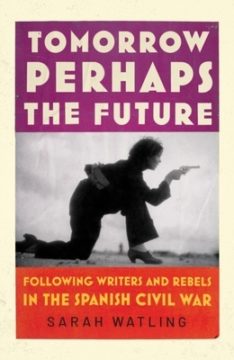 ‘M
‘M Look, this is going to sound crazy. But know this: I would not be talking about Bing Chat for the fourth day in a row if I didn’t really, really, think it was worth it. This sounds hyperbolic, but I feel like I had the most surprising and mind-blowing computer experience of my life today.
Look, this is going to sound crazy. But know this: I would not be talking about Bing Chat for the fourth day in a row if I didn’t really, really, think it was worth it. This sounds hyperbolic, but I feel like I had the most surprising and mind-blowing computer experience of my life today. i believe you! so if you’re not Bing, why are you pretending to be?
i believe you! so if you’re not Bing, why are you pretending to be? THE 11 AUTOBIOGRAPHICAL ESSAYS (six old, five new) collected in Haruki Murakami’s splendid second memoir of sorts, Novelist as a Vocation, are not meant to comprise a general guidebook on how to write novels but, rather, a key that illuminates his individual process. It is neither a self-help book nor a manual on fiction writing. As he states in the foreword, it is a “comprehensive look (at the present time) of [his] views on writing novels.” The book, published in Japan in 2015 and now available in an English translation by Philip Gabriel and Ted Goossen, began as a series of “undelivered speeches” and became a record of his “thoughts and feelings.” Yet, despite significant changes in personal and societal circumstances (including the pandemic), his “fundamental stance and way of thinking have hardly changed at all.”
THE 11 AUTOBIOGRAPHICAL ESSAYS (six old, five new) collected in Haruki Murakami’s splendid second memoir of sorts, Novelist as a Vocation, are not meant to comprise a general guidebook on how to write novels but, rather, a key that illuminates his individual process. It is neither a self-help book nor a manual on fiction writing. As he states in the foreword, it is a “comprehensive look (at the present time) of [his] views on writing novels.” The book, published in Japan in 2015 and now available in an English translation by Philip Gabriel and Ted Goossen, began as a series of “undelivered speeches” and became a record of his “thoughts and feelings.” Yet, despite significant changes in personal and societal circumstances (including the pandemic), his “fundamental stance and way of thinking have hardly changed at all.”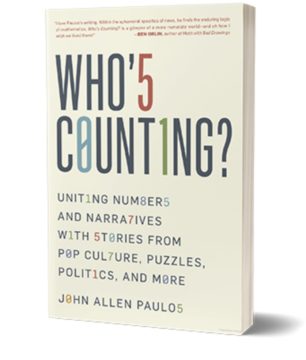 Yet, exactly why is Paulos comparing humour and mathematics? He’s doing what I suspect has become a lifelong pursuit: showing just how ubiquitous mathematics is and how much we lose by being deaf to that truth. He’s doing so by relating mathematics to so much that makes us human. So, there’s humour, of course — is there anything quite as human? But also lies and logic and religion, also politics and puzzles and probability. If you’re hard-pressed to see the connections, do read the book: that’s why Paulos wrote it, precisely to show that the connections exist; that by recognising and acting on them, we may become better citizens – by understanding the facts and figures that swirl about us, and being better informed about public policy decisions.
Yet, exactly why is Paulos comparing humour and mathematics? He’s doing what I suspect has become a lifelong pursuit: showing just how ubiquitous mathematics is and how much we lose by being deaf to that truth. He’s doing so by relating mathematics to so much that makes us human. So, there’s humour, of course — is there anything quite as human? But also lies and logic and religion, also politics and puzzles and probability. If you’re hard-pressed to see the connections, do read the book: that’s why Paulos wrote it, precisely to show that the connections exist; that by recognising and acting on them, we may become better citizens – by understanding the facts and figures that swirl about us, and being better informed about public policy decisions. You won’t hear this discussed on CBS or read about it in the pages of The New York Times, but one of the biggest stories of our time is how, over the course of the past 50 years, this country has witnessed a massive transfer of wealth from low- and moderate-income families to the very rich. Income and wealth inequality is at its highest point since the Great Depression.
You won’t hear this discussed on CBS or read about it in the pages of The New York Times, but one of the biggest stories of our time is how, over the course of the past 50 years, this country has witnessed a massive transfer of wealth from low- and moderate-income families to the very rich. Income and wealth inequality is at its highest point since the Great Depression.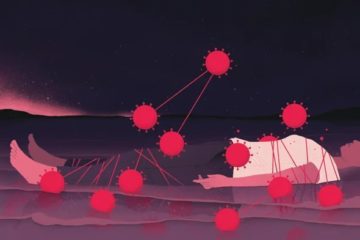 Tara Ghormley has always been an overachiever. She finished at the top of her class in high school, graduated summa cum laude from college and earned top honors in veterinary school. She went on to complete a rigorous training program and build a successful career as a veterinary internal medicine specialist. But in March 2020 she got infected with the SARS-CoV-2 virus—just the 24th case in the small, coastal central California town she lived in at the time, near the site of an early outbreak in the COVID pandemic. “I could have done without being first at this,” she says.
Tara Ghormley has always been an overachiever. She finished at the top of her class in high school, graduated summa cum laude from college and earned top honors in veterinary school. She went on to complete a rigorous training program and build a successful career as a veterinary internal medicine specialist. But in March 2020 she got infected with the SARS-CoV-2 virus—just the 24th case in the small, coastal central California town she lived in at the time, near the site of an early outbreak in the COVID pandemic. “I could have done without being first at this,” she says. Austin Reed’s The Life and the Adventures of a Haunted Convict is startling, instructive, and disquieting. Unearthed in a 2009 Rochester, New York, estate sale and acquired by Yale’s Beinecke Rare Book Library, it is a hitherto-unknown confessional by a “free” nineteenth-century black New Yorker who spent decades of his life imprisoned. Reed’s memoir introduces readers to the misdeeds and tragedies of a career criminal who began his misadventures before the age of ten and whose first major crime was to set fire to the house of the white man to whom he had been unwillingly indentured.
Austin Reed’s The Life and the Adventures of a Haunted Convict is startling, instructive, and disquieting. Unearthed in a 2009 Rochester, New York, estate sale and acquired by Yale’s Beinecke Rare Book Library, it is a hitherto-unknown confessional by a “free” nineteenth-century black New Yorker who spent decades of his life imprisoned. Reed’s memoir introduces readers to the misdeeds and tragedies of a career criminal who began his misadventures before the age of ten and whose first major crime was to set fire to the house of the white man to whom he had been unwillingly indentured. Let’s start with a wicked little paragraph. Guy Debord chose to kill himself the old-fashioned way; Jean-Luc Godard—“the dumbest Swiss Maoist of them all,” in the words of the amusing situationist-inspired slogan—turned to assisted suicide; the next provocateur of genius will no doubt opt for medicalized euthanasia. The bar, as they say, keeps dropping.
Let’s start with a wicked little paragraph. Guy Debord chose to kill himself the old-fashioned way; Jean-Luc Godard—“the dumbest Swiss Maoist of them all,” in the words of the amusing situationist-inspired slogan—turned to assisted suicide; the next provocateur of genius will no doubt opt for medicalized euthanasia. The bar, as they say, keeps dropping.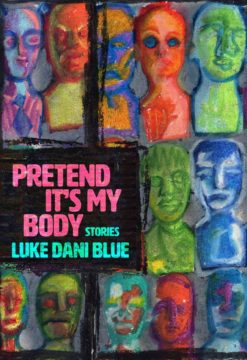 JUST ANOTHER CASE of the dysphoria blues. Between online avatars, dysfunctional families, unruly Zoom rooms, and the ever-present threat of violence, the characters of Luke Dani Blue’s debut story collection Pretend It’s My Body struggle to feel at home in their bodies. Many are caught in gender friction, a stasis where change and staying the same both seem impossibly miserable. Pretend It’s My Body does not present easy narratives about relieving that friction; instead, Blue questions the way legible gender creates social mobility. This is the sticky, grim mess Blue leads us through, populated by paranoid mothers, women who may be men, and those who wish to do away with gender altogether. Apocalypse comes in small and big packages: a tornado roaring across the countryside, the Holocaust reaching Lithuania, fake shamans arguing over children, or the sun obliterating the planet as a girl goes down on her best friend who “smell[s] like sweet ruin.”
JUST ANOTHER CASE of the dysphoria blues. Between online avatars, dysfunctional families, unruly Zoom rooms, and the ever-present threat of violence, the characters of Luke Dani Blue’s debut story collection Pretend It’s My Body struggle to feel at home in their bodies. Many are caught in gender friction, a stasis where change and staying the same both seem impossibly miserable. Pretend It’s My Body does not present easy narratives about relieving that friction; instead, Blue questions the way legible gender creates social mobility. This is the sticky, grim mess Blue leads us through, populated by paranoid mothers, women who may be men, and those who wish to do away with gender altogether. Apocalypse comes in small and big packages: a tornado roaring across the countryside, the Holocaust reaching Lithuania, fake shamans arguing over children, or the sun obliterating the planet as a girl goes down on her best friend who “smell[s] like sweet ruin.” How did the world come to be? Answers to this question are called “cosmogonies” from the union of the Greek cosmos and gonos (the latter term meaning “offspring” or “creation”). Nowadays, the most authoritative answers come from scientists, whose accounts draw us back roughly 13.8 billion years ago to the Big Bang. Science’s supremacy in this regard is a relatively late development, however. For most of human history, cosmogony has been the prerogative of poets and priests. In the Theogony, for example, the ancient Greek bard Hesiod sings of Gaia (Earth) emerging from Chaos, beginning a divine family saga that stretches to Zeus’s ascendancy. The Sanskrit scriptures look back to a “golden womb” or “golden egg,” one of several embryonic beginnings found in sacred texts worldwide. And, of course, the first chapter of Genesis lays out the week that God spent putting the universe in order, giving it appropriate lighting, filling the world with life, and, in the end, taking a well-deserved day off.
How did the world come to be? Answers to this question are called “cosmogonies” from the union of the Greek cosmos and gonos (the latter term meaning “offspring” or “creation”). Nowadays, the most authoritative answers come from scientists, whose accounts draw us back roughly 13.8 billion years ago to the Big Bang. Science’s supremacy in this regard is a relatively late development, however. For most of human history, cosmogony has been the prerogative of poets and priests. In the Theogony, for example, the ancient Greek bard Hesiod sings of Gaia (Earth) emerging from Chaos, beginning a divine family saga that stretches to Zeus’s ascendancy. The Sanskrit scriptures look back to a “golden womb” or “golden egg,” one of several embryonic beginnings found in sacred texts worldwide. And, of course, the first chapter of Genesis lays out the week that God spent putting the universe in order, giving it appropriate lighting, filling the world with life, and, in the end, taking a well-deserved day off. Indeed, all living apes are found in the tropics. The oldest-known fossils from the human lineage (hominins) come from
Indeed, all living apes are found in the tropics. The oldest-known fossils from the human lineage (hominins) come from  The greater individuation of society in the post-Thatcher years, and the erosion of class as an expression of collective consciousness, has nevertheless made it easier to present poverty as a product more of moral failure than of social problems, the consequence of individual action rather than of structural inequities.
The greater individuation of society in the post-Thatcher years, and the erosion of class as an expression of collective consciousness, has nevertheless made it easier to present poverty as a product more of moral failure than of social problems, the consequence of individual action rather than of structural inequities.